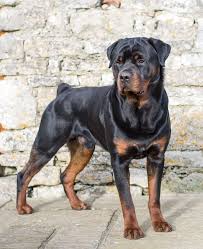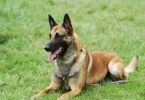
Today the Rottweiler is known as a German breed. It is named after the town of Rottweil in Germany. However, the breed is over 2000 years old and was found in Italy where the Roman legions used them to herd livestock over the Alps and guard the weapon depots at night. Legend has it that the butchers would tie their profits to the dog’s collar, where no wrongdoers would dare to touch it. The Germans from Rottweil saved the breed from extinction by establishing a sound breeding program that emphasized the dog’s physical soundness and working abilities, which included herding, cart pulling, tracking, obedience and protection skills.
An inherent protector, the Rottweiler is self-confident and responds quietly and with a wait-and-see attitude to influences in his environment. Typical Rottweilers are neither shy or aggressive. They are calm and confident, steady tempered and serious. They are loving to their own family, however are aloof with strangers and need to be introduced and socialized to visitors, veterinarians and other people they will encounter throughout their lifetime. They bond closely with family members and are known to follow their owner from room to room lying at their feet. They are very popular as personal protection dogs, as they do not bark excessively and are not overly active. By the same token they are not recommended for jobs that require endurance, especially in the heat. They are most natural in the role of bodyguard and no doubt have a commanding appearance.
They are physically strong in body and temperament and are not recommended for a first time dog owner or owner with a pushover personality. They need to be shown their hierarchy within the pack. This breed should definitely be obedience trained at a early age. They will become out of control without proper training and direction. Most catch on quickly to basic obedience commands and most often seem willing to please. They can be trained to enjoy dog sports and perform quite well in competition. They need to be socialized at a early age with a variety of people other than family members. They may refuse commands from family members who have not established leadership over them. Ongoing socialization, obedience, exercise and companionship are an absolute must for this breed.
I have known many of this breed throughout the years. All of them that I have come into contact with were genuinely friendly once introduced. They have a loud, deep, bark that can be quite menacing. I certainly wouldn’t walk into the backyard of one whom I did not know personally. I have seen several show aggression to men in particular. I have seen them be aggressive with other dogs of both sexes, including those in their pack. They are very strong physically and need to be taught loose leash walking at a young age, unless you want to be dragged around like a rag doll. Rottie’s are too strong and determined to be forced. What they do is done out of love and respect for the owner.
He must be medium in size and his coat is black with rust to mahogany markings. Males stand 24-27 inches, females stand 22-25 inches. They should weigh between 85 and 115 pounds.
The Rottweiler requires minimal grooming, however they shed quite heavily. Their short coat is coarse and dense. The Rottweiler should be brushed on a weekly basis to remove loose hair and distribute the skins natural oils to help maintain the coat and keep it shiny and healthy. Slicker brushes are a good choice for brushing. Twice a year this breed sheds heavily, so you may need to brush 3-4 times per week during these phases. He will need his ears cleaned and nails trimmed on a regular basis, about once a month should suffice for a healthy dog. Bathe only as needed.
As with any purebred they have common health problems, the most prevalent being hip dysplasia, thyroid, Von Willebrand’s disease, cataracts and are acceptable to bloat. In our environment today, I have seen many develop bone cancer, most likely attributed to poor diet choices. Many of the Rottweilers that I have seen tend to suffer from canine allergies. This could very well be due to their diet of processed commercial food. Their average lifespan is ten years.
Cautions when Buying
There are many Rottweilers around so be careful! Look for a breeder who strives for good conformation and working ability in obedience. Show -only breeders produce good family pets, but Schutzhund breeders often produce dogs that are too aggressive. If you buy from a poor breeder or raise the dog incorrectly, you could wind up with a overly dominate, aggressive Rottie. Don’t choose the boldest or most independent or timid puppy.For guidance on choosing your prepper puppy read our post on temperament testing puppies.
On a scale of 1-10, I personally rate the Rottweiler 8 on the Prepper Dog list. Although there are claims of them not performing well in endurance and heat, it is best to keep a watchful eye on their weight and keep them physically fit with daily vigorous exercise.
References: American Kennel Club
The Business Security Canine






